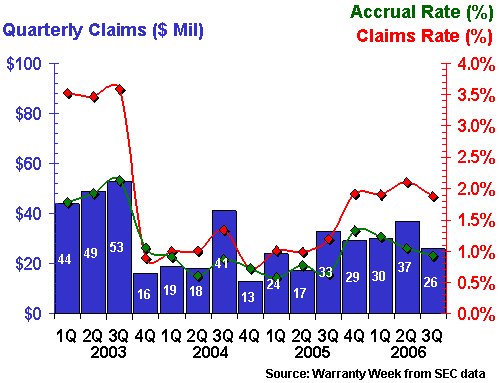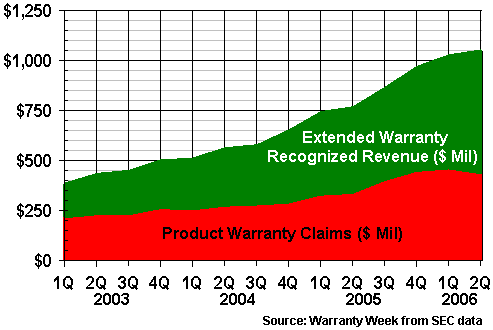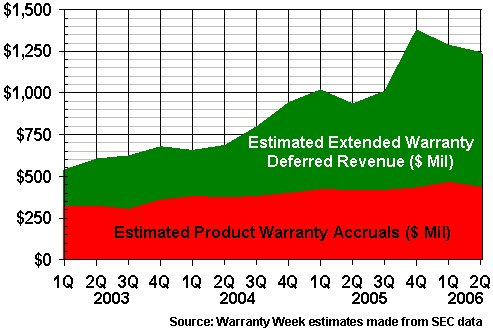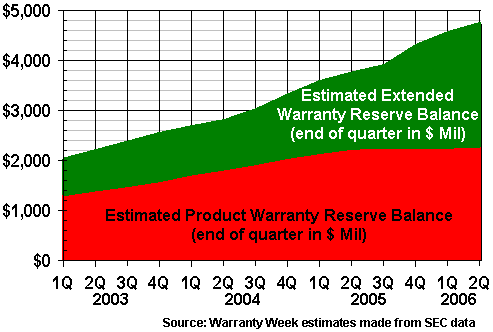Dell's Warranty Accounting:
Dell is now seriously late with its quarterly financial reports because of investigations some say were prompted by its peculiar warranty accounting methods. Meanwhile, Apple's seems to have turned a corner regarding its recent iPod warranty problems.
Although it's a new year, there are still some lingering warranty issues from 2006 that need to be discussed. And given that January is named for the deity whose two faces look forwards and backwards at the same time, this is the month for such a discussion.
First, we last checked in with the top 100 warranty providers in the newsletter dated Dec. 12, 2006. Two days later, Dell Inc. informed the U.S. Securities and Exchange Commission that it would not be able to file a financial statement on time for the quarter ended Nov. 3, 2006, because of several ongoing investigations. This followed a similar filing three months ago in which the company said it would not be able to file for the quarter ended August 4.
Since that time, numerous publications have begun to speculate about the reason for the investigations, and the theory persists that it is somehow related to warranty. More specifically, it is said to relate to the way in which Dell mingles basic product warranties with extended service plans. Dell has consistently had no comment on the matter, and we have no new theories to offer, but we thought it would be useful to try and unmingle the two.
Second, just before New Year's Eve, Apple Computer Inc. beat a year-end deadline to file its delayed annual report for the fiscal year ended September 30, 2006. And just this morning, the company changed its name to Apple Inc., in recognition of its transition from a computer manufacturer into an entertainment and electronics company.
Third, Lucent Technologies Inc., having merged with Alcatel on Nov. 30, nevertheless filed its farewell annual report with the SEC on Dec. 14. We thought it timely to take a last look at the company's warranty experience before it becomes foreign-owned, and therefore is no longer required to report to the SEC.
Investigating Dell
Let's start with Dell. The company initially said it was unable to file because of questions raised by an SEC investigation "into certain accounting and financial reporting matters," which it said "have indicated the possibility of misstatements in prior period financial reports, including issues relating to accruals, reserves and other balance sheet items that may affect the company�s previously reported financial results."
That investigation began in August 2005 but wasn't disclosed publicly until August 2006. Since then, not only has the SEC launched a formal investigation, but also now so has the United States Attorney for the Southern District of New York as well as Dell's own Audit Committee. On Jan. 1, Donald J. Carty, a longtime Dell board member and retired airline executive who had been the chairman of that Audit Committee, took over as Dell's vice chairman and Chief Financial Officer. He replaces James M. Schneider, who after a decade as CFO is leaving Dell to run a bank.
Dell has declined to provide any additional details on what these investigations have uncovered, which has created a vacuum that observers are now filling with their own theories. Many think the "accruals, reserves and other balance sheet items" refer to warranty accounting, but nobody is sure. Clay Sumner, an analyst at Friedman, Billings, Ramsey & Co. Inc., said in a new report that he thought Dell was under-accruing for warranty and was therefore overstating earnings by between 2 cents and 8 cents per share in five of the last 12 quarters. Equity analyst William Trent said in a newsletter called Stock Market Beat that it was no big deal -- that he remains unconvinced Dell had used accruals to manipulate earnings.
Industry trade magazine CRN weighed in with an analysis on Nov. 21 and a follow-up on Dec. 1 that also pointed to warranty accruals as the reason for the investigations. Reporter Edward Moltzen also referred to Warranty Week's Oct. 25, 2005 article on the extended warranty revenues of the major computer manufacturers, in which we suggested that up to 38% of Dell's operating income may come from sales of service plans.
A Dell spokesman told Moltzen that the company would not comment on that conclusion or discuss other aspects of its warranty accounting in any detail. "Our previous financial reports will have to speak for themselves," the spokesman told CRN. "We are in a period where we are choosing not to comment beyond what we have so far regarding our financial statements. We will be choosing not to comment on this one."
So let's see what those financial reports have to say for themselves. Dell usually details its warranty accounting in a note to its financial statements under the heading of "aggregate deferred revenue and warranty liability." Here are the last 14 such reports, covering the period from Feb. 1, 2002 to May 5, 2006.
Figure 1
Dell's Reports to the SEC,
Aggregate Deferred Revenue & Warranty Liability
Feb. 2002 to May 2006
(in $ Millions)
| Time Period | Begin | Rev Defer | Service | Amort of | End |
| of | of | & Costs | Oblig | Deferred | of |
| SEC Report | Period | Accrued | Honored | Revenue | Period |
| 12 mo end 1/31/03 | 1,447 | + 2,137 | - 868 | - 674 | = 2,042 |
| 3 mo end 5/2/04 | 2,042 | + 601 | - 232 | - 201 | = 2,210 |
| 6 mo end 8/1/03 | 2,042 | + 1,221 | - 464 | - 419 | = 2,380 |
| 9 mo end 10/31/03 | 2,042 | + 1,896 | - 726 | - 658 | = 2,554 |
| 12 mo end 1/30/04 | 2,042 | + 2,547 | - 983 | - 912 | = 2,694 |
| 3 mo end 4/30/04 | 2,694 | + 683 | - 275 | - 288 | = 2,814 |
| 6 mo end 7/30/04 | 2,694 | + 1,480 | - 557 | - 585 | = 3,032 |
| 9 mo end 10/29/04 | 2,694 | + 2,420 | - 846 | - 946 | = 3,322 |
| 12 mo end 1/28/05 | 2,694 | + 3,435 | - 1,176 | - 1,359 | = 3,594 |
| 3 mo end 4/29/05 | 3,594 | + 933 | - 339 | - 427 | = 3,781 |
| 6 mo end 7/29/05 | 3,594 | + 1,942 | - 741 | - 889 | = 3,906 |
| 9 mo end 10/28/05 | 3,594 | + 3,318 | - 1,191 | - 1,408 | = 4,313 |
| 12 mo end 2/3/06 | 3,594 | + 4,603 | - 1,651 | - 1,974 | = 4,572 |
| 3 mo end 5/5/06 | 4,572 | + 1,238 | - 438 | - 612 | = 4,760 |
Source: Dell's SEC Form 10Q & 10K reports
The first column describes the time period covered by the report: either three, six, nine, or 12 months. The second column provides a beginning balance for Dell's aggregate deferred revenue and warranty liability. The third column combines revenue deferred from sales of extended warranties and costs accrued for new product warranties. The fourth column reflects what Dell calls "service obligations honored," which we interpret to mean "claims paid."
The fifth column is for the amortization of deferred revenue, which is what happens with service contracts as time passes. When an extended warranty is initially sold, all the money is added into the third column, deferring its recognition until time passes. For instance, if a four-year warranty is sold for $100, that revenue is immediately deferred, and is then recognized evenly at a rate of $25 a year. After one year, $25 has been recognized and $75 remains deferred. After three years, $75 has been recognized and $25 remains deferred. Alternatively, the company could recognize $2.08 per month for 48 months, or $6.25 per quarter for 12 quarters. Or it could come up with a schedule that tracks actual expenses.
The important concept to remember is that according to a 1990 Financial Accounting Standards Board publication called Technical Bulletin No. 90-1, "Accounting for Separately Priced Extended Warranty and Product Maintenance Contracts," all revenue from service plans must be deferred and then recognized, or amortized, as Dell likes to call it.
The sixth column reflects the ending balance, consisting of all money set aside to pay for warranty claims (service obligations) as well as all deferred revenue not yet recognized (amortized). In each of these 14 reports, the items in columns two through five should always add up to what's in column six.
Overlapping Reports
Like most manufacturers, Dell details its warranty expenditures in three, six, nine, and 12 month periods, as opposed to four periods of three months each. It therefore becomes a minor mathematical chore to convert from one methodology to the other. For instance, to derive the numbers for the fourth quarter alone, one must subtract the nine-month figures from the 12- month figures. Therefore, "service obligations honored" during the quarter ended Feb. 3 totaled $460 million, equal to the $1,651 million reported for 12 months minus the $1,191 million reported for nine months ended Oct. 28, 2005.
That's the easy part. The hard part is separating the figures into basic and extended warranties. Column four belongs with basic product warranties, while column five belongs with extended warranties. But columns two, three, and six are mixtures of the two. And that, industry observers say, is what might be at the root of all these investigations. Like a kosher butcher selling ice cream, Dell could be breaking the rules when it comes to separating meat and dairy.
That would certainly be the case if there were any rules. But while only three or four of the 800 manufacturers tracked by Warranty Week combine their basic and extended warranty accounting in this way, we can find no rule that specifically prohibits them from doing so. Indeed, the Dell method may impede financial analysis, but one would hope the slumbering SEC could have made an effort to investigate other manufacturers that don't report their warranty balances at all, or do so only once a year.
Government Work
Then again, we're not accountants and we're certainly not government accountants, so maybe they know something they're not saying. But if this turns out to be nothing more than concern over Dell's mixing of basic and extended warranties, then the SEC is wasting everybody's time with this investigation.
Managing earnings by manipulating accruals would be a more serious accusation, of course. But before one could suggest that Dell was either over- or under-accruing for product warranties, one would have to know what Dell was accruing. And nobody outside of Dell and its tormenters knows that for sure. We don't know either, but for the past four years we've made our best guesses every time Dell files its quarterly statement. What we have to do is split the equations detailed in Figure 1 into:
| Basic Warranty | Extended Warranty |
|---|---|
| Beginning Balance | Beginning Balance |
| - Claims Paid | - Recognized Revenue |
| + Accruals Made | + Deferred Revenue |
| = Ending Balance | = Ending Balance |
Let's take a look at what we know, which is the total for claims paid and recognized revenue, which under the Dell method are called service obligations honored and amortization of deferred revenue. In the most recent quarter, for instance, Dell registered $438 million in claims paid and $612 million in revenue recognized. That was the ninth consecutive quarter in which the latter exceeded the former, which essentially means that Dell is making lots of money on its sales of extended warranties.
Figure 2 tracks these two measures over the past 14 quarters. The one first exceeded the other during what we're calling the second quarter of 2004, which on Dell's schedule would be the first quarter of the fiscal year ended Jan. 28, 2005. As is detailed in Figure 1, claims during that quarter totaled $275 million while recognized revenue totaled $288 million.
Figure 2
Dell's Warranty Reports to the SEC,
Service Obligations Honored vs. Amortization of Deferred Revenue
2003 to 2006
(in $ Millions)
Click on the image above to see a larger graphic.
Notice how product warranty claims seem to have peaked during the first quarter of 2006. This is indeed what seems to have happened. During the quarter ended Oct. 28, 2005, Dell reported $450 million in claims, which grew to $460 million in the quarter ended Feb. 3 and then fell back to $438 million in the quarter ended May 5. The company's claims rate, however, continues to rise because claims are increasing at a faster rate than product sales. And of course, extended warranty revenue continues to grow unabated, both in dollars and as a percentage of total sales.
Now, here's the hard part. How do we separate revenue deferred (extended warranty) from accruals made (product warranty)? For instance, in the most recent quarter, Dell reported $1.238 billion in combined deferrals and accruals. How much of which was which?
Accruals Approximate Claims?
We're going to have to take a guess, and in order to do so we're going to have to assume that Dell is accruing more or less as much as it is paying out in claims. Among large manufacturers, the warranty reserve balance is always the most stable metric of all, because claims and accruals are usually close enough to keep the total in a narrow range. So if Dell is paying out $438 to $460 million per quarter in claims, we're guessing it's not accruing either $600 million or $200 million to cover the expense. Then again, maybe it is, and this is why it's under investigation. If it accrued too much, it would be depressing earnings and reducing taxes paid. If Dell was under-accruing, as Wall Street analyst Clay Sumner suggests in his report, then it would be inflating earnings and paying too much taxes.
We have no idea which it is, but again, before one can make conclusions about the over/under, one must have some concept of the numbers. We're going to suggest that basic product warranty accruals are over sometimes and under other times, but not by incredible amounts. For instance, in Figure 3 we're assuming that during the past year, accruals (in red) have been no more than $10 million over or $22 million under claims paid (the red section in Figure 2).
Figure 3
Dell's Reports to the SEC,
Revenue Deferred vs. Costs Accrued for New Warranties
2003 to 2006
(in $ Millions)
Click on the image above to see a larger graphic.
If such an assumption is accurate, then the money must be coming from somewhere, because the combined balance is soaring. If, for example, we're assuming $440 million in accruals and $450 million in claims during the quarter ended Oct. 28, 2005, then mathematically we must be assuming that deferred revenue was $936 million and recognized revenue was $519 million, because that's the only way that the combined balance could have jumped by $400 million during that quarter.
In Figure 4, we're simply taking the reported totals and dividing them between basic product warranty and extended warranty. For instance, we know for certain that the combined ending balance for May 5, 2006 was $4.76 billion (Figure 1, column 6). What we're estimating is that $2.27 billion was in the basic product warranty bucket as of that date while $2.49 billion was in the extended warranty bucket.
Figure 4
Dell's Reports to the SEC,
Aggregate Deferred Revenue vs. Warranty Reserve Balance
2003 to 2006
(in $ Millions)
Click on the image above to see a larger graphic.
Interestingly, as Figure 4 illustrates, the extended warranty bucket always used to be smaller than the basic product warranty bucket. It wasn't until Feb. 3, 2006, according to our model, that extended warranty deferred revenue exceeded product warranty reserves. For while product warranty reserve levels have remained close to $2.2 billion for the past year-and-a-half, the amount of deferred-but-not-yet-amortized extended warranty revenue has soared.
Again, this is just our conjecture. We're assuming that corporations behave rationally, and that Dell is setting aside roughly as much as it's spending on warranty claims, give or take a bit. We wish that Dell would disclose to not only the SEC but also to all its shareholders how much it actually accrues for product warranties. Alternatively, perhaps one of our numerous readers within Dell might give us some confidential guidance instead of continuously deferring to the PR department's wall of "no comment." But until something changes, we'll have to continue to extrapolate.
Let the Sunshine In
What a relief it was, then, to discover that Apple filed its third fiscal quarter and annual reports at the end of December. If Dell is the enigma of the computer industry, then Apple is the klieg light. In the way that it segments its revenue and in the way it separates its basic and extended warranty accounts, it serves as a template for all others who don't know what rules to follow when reporting warranty expenses. Indeed, before Dell and Gateway began segmenting their product revenue, we simply used to apply Apple's ratios to their revenue totals.
Figure 5 brings Apple's figures up to date. Charts in the Dec. 12 newsletter and on the Warranty Week home page have been fixed retroactively to include these figures. And what these figures tell us is fairly good news. While Apple's claims rate has been nudged up from 1.6% to 1.7%, and while claims paid have jumped from $153 million during the first nine months of calendar 2005 to $190 million in calendar 2006, what Figure 5 tells us is that claims peaked a year ago.
Figure 5
Apple Inc.
Warranty Claims & Accruals
2003 to 2006
(in $ Millions & Percent)

That's not to say that the iPod and its batteries aren't a continuing headache. But it does suggest that this is as bad as it gets, and that portable music players are not going to cause the company's warranty claims to soar. Yes, a 1.5% to 2% claims rate is higher than normal for Apple, but it's not the 5% or 6% rate that some portable handheld manufacturers consider to be typical.
Finally, we have to say goodbye to Lucent Technologies, which has merged with the French telecommunications giant Alcatel. But before they left us, they filed one last annual report with the SEC, for the fiscal year ended September 30. The addition of those new data points results in Figure 6.
Figure 6
Lucent Technologies Inc.
Warranty Claims & Accruals
2003 to 2006
(in $ Millions & Percent)

What's notable about Lucent's chart is how there's absolutely no baseline. Ask us in 2003 and we would have said that Lucent's claims rate was around 3.5%. Ask us in 2004 or 2005 and we would have said it was closer to 1%. But in the past year it's oscillated around 2%.
As a result, Lucent ends its brief corporate history with warranty claims up from $74 million during the first nine months of calendar 2005 to $93 million in the same period of 2006. Its claims rate was up 58% over the same period, which earned it a place on several charts in the Dec. 12 newsletter. Alcatel, meanwhile, has seen its claims rate trend downwards from the 2.5% range in 2003 to the 1.5% range now. It will be interesting to see how this merger affects their combined totals.
Early Bird Discount Expiring Soon
Registration opened in November for the upcoming Warranty Chain Management Conference with the "Early Bird" discount offering a savings of $200 for a limited period. With less than nine weeks before the start of the event, this discount will end this coming weekend. All registration forms received by ALG Associates on or before January 14th will qualify for the discounted registration fee of $1,075 per person; $967 per person when groups of 3 or 4 people register (an additional 10% discount); and $860 per person when group of 5 or more register (an additional 20% discount).
The conference will present attendees with the opportunity to benefit from:
- Pre-conference workshops presented by SAS, Fulcrum Analytics, Ubiquiti, and Pontifex Consulting.
- Keynote presentations from Steve Manning, senior vice president of Solectron; and Bill Owens, vice president of service & support at Lenovo.
- The knowledge and experience of 50 warranty professional and business executive speakers from major companies.
- The information available from 12 tracks and 42 papers discussing: Globalization & Growth; End-to-End Management Processes; Warranty Finance & Fraud; Managing Extended Warranties; Cost Reduction & Customer Satisfaction; Warranty Services, Logistics & Risk; Warranty Recall Management; Best-in-Class Warranty; Warranty Analytics; Putting Tools to Use; Warranty and the Law; Warranty Processes and Technologies.
- Industry updates from Warranty Week, Manufacturing Insights and the new Institute of Warranty Chain Management (iWCM).
- Interactive executive panel discussion on issues relating to recall management and how globalization is impacting warranty management.
- Presentation and panel discussion from the Automotive Industry Action Group (AIAG).
- Two networking cocktail evening events with hors d�oeuvres (sponsored by SAS Institute and Snap-on Business Solutions).
For further details and to register contact Alison Griffiths at alison@algassociates.com or call +1 (408) 493-5172.












